SOUTHWEST REGION
Rainfall limited harvest progress over the past week but many producers were able to resume harvest operations over the weekend. Cereal harvest ranges from 35 to 60 per cent complete with more progress seen south of Highway #1. Yields are reported to be average with quality being reduced because of the wet conditions. Most crop harvested to date has required drying.
Producers should be able to harvest crops dry this week; however the biggest issue is wet field conditions. Canola harvest is 30 to 50 per cent complete with producers reporting average yields with good quality to date.
Read Also

Manitoba sclerotinia picture mixed for 2025
Variations in weather and crop development in this year’s Manitoba canola fields make blanket sclerotinia outlooks hard to pin down
No reports of flax being harvested. Frost the previous week has affected corn and sunflowers. Very little winter wheat has been planted as land is not available. Harvesting of secondcut alfalfa continues to be a challenge due to wet weather. Quality has been reduced as well. Little to no slough hay has been cut throughout the entire region.
CENTRAL REGION
There was very little harvest progress this past week due to wet conditions. A limited amount of crop came off on the weekend where conditions allowed.
Several days of good drying weather are needed to get producers back onto the fields, especially where swaths are sitting in water. Cereal grains harvest is reported to be 95 to 100 per cent complete across the region. Most of the crop was harvested earlier with good grades. Later harvested fields have suffered grade loss due to rain and wet field conditions. Sprouting is a concern. Canola harvest is mostly complete in the Red River Valley while progress is 85 to 95 per cent complete on the escarpment area.
Remaining swaths are deteriorating. Flax is mature and harvest is progressing. To date harvested fields have average to above-average yields and good grades. Canaryseed is being harvested; yields are average to above average. Field beans are mature, but crop that is lying in swath is deteriorating due to wet conditions. Yield reports of 1,200 to 1,500 lbs./acre in southern areas; Portage area reports yields above 1,800 lbs./acre.
Some soybean fields have been harvested with yields ranging between 30 to 40 bushels/ acre. Head rot in many sunflower fields is worsening with ongoing wet conditions, affecting both potential yield and quality. Harvest will start as soon as conditions allow. Corn is maturing nicely. Silage harvest has begun. New potato harvest is progressing but is challenging depending on soil moisture levels.
Harvest is most advanced in the Carberry area at 50 to 60 per cent of potatoes dug, with yields above average. Other areas report up to 30 to 40 per cent harvested; excess moisture is causing concerns for storability. Acres of winter wheat and fall rye seeded are below average due to field conditions.
Second-cut hay is mostly completed with generally good yields. Quality is fair to good. Pastures are keeping up with grazing and are in good condition; growth is slowing. Many fields have standing water. Drains are full, and in some cases, provincial drains are backing up into fields in eastern areas. Field operations are difficult. Very little, if any, fall fertilizer has been applied, due to wet soils.
EASTERN REGION
Rainshowers during the week prevented producers from making any progress in harvesting their 2010 crop. Cereal crop harvest is nearly 100 per cent complete with the exception of oats where harvested acres are 95 per cent complete with remaining acres still in swath.
Oat yields range from 30 bushels/acre in northern regions to 120 bushels/acre in southern regions of the district with reports of light test weight samples from the entire region.
Overall wheat yields ranged from 15 to 60 bushels/acre with below-average quality reported in northern districts while southern areas reported average yields and quality.
Oilseed harvest is 95 per cent complete with canola and flax remaining to be harvested. Canola yields range from five to 45 bushels/acre with average quality. Flax is yielding between five to 25 bushels/acre with average quality.
Soybeans harvest got underway. Sunflower yield potential continues to vary greatly because of excess water. Corn continues to dry down with average yields expected. Winter wheat seedling emergence was good to excellent with plants in the two-to three-leaf stage. However, recent precipitation will affect plant health as excess moisture continues to affect fields in the region.
Progress in general field work was limited as a result of the precipitation throughout the week. The past week was challenging for hay producers as they attempted to make hay. Some producers are supplementing feed on pastures while others have started their second cut of hay on fields that were late with the first cut.
Quality continues to be an issue for all hay being produced while the conditions of the pastures deteriorate due to excess moisture.
INTERLAKE REGION
Intermittent rains fell through the week with varying accumulation amounts. Warm and windy conditions on the weekend provided a good start to drying cropland so that general harvest operations can resume. Very little harvest took place during the week. Soybean harvesting began in the Teulon area early in the week and yields are reported in the 35 bushels/acre range. Cereal and canola harvest did resume on Sunday. Very wet soil conditions are causing harvesting equipment to leave ruts in fields.
Very little tillage has taken place. Mouldboard plowing is taking place on some farms in the north to renovate forage seed fields and bury residue from annual crops. Haying activity was limited to round bale haylage on a few acres over the week.
Feed and straw supplies remain a concern to producers in the region. Chopping of corn silage has begun in the southern areas but poor weather has delayed any further progress. Some alfalfa seed crops will be harvested for forage, although quality will likely be poor.
Pasture conditions are very wet with only slight regrowth on higher ground. Most producers are moving cattle towards fall grazing pastures and secondcut hayfields.
Some cornfields will be grazed instead of harvested as large portions of the crop suffered from excess moisture.


















